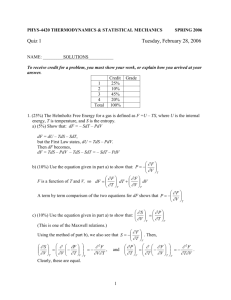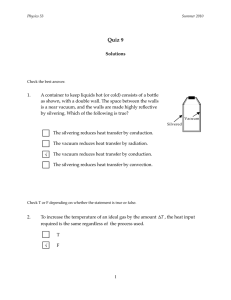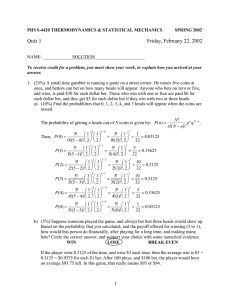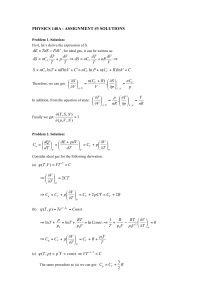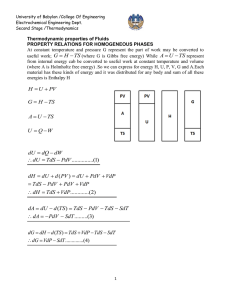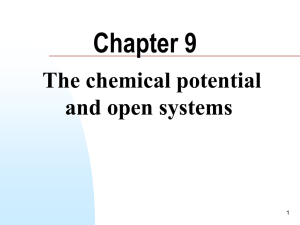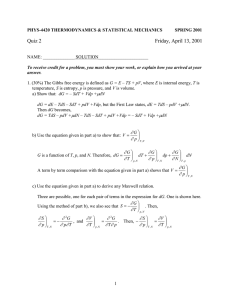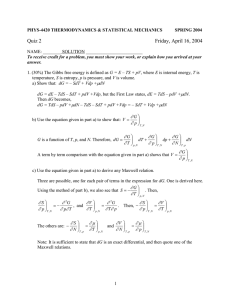s05q1ans.doc
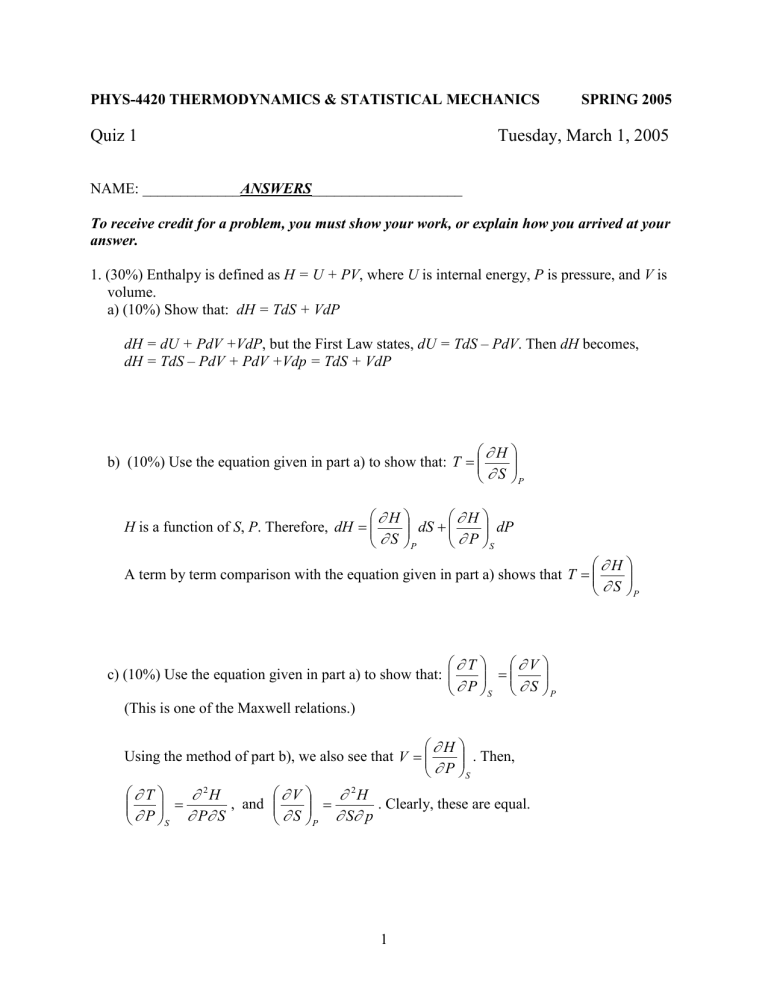
PHYS-4420 THERMODYNAMICS & STATISTICAL MECHANICS SPRING 2005
Quiz 1 Tuesday, March 1, 2005
NAME: _____________ ANSWERS ____________________
To receive credit for a problem, you must show your work, or explain how you arrived at your answer.
1. (30%) Enthalpy is defined as H = U + PV , where U is internal energy, P is pressure, and V is volume. a) (10%) Show that: dH = TdS + VdP dH = dU + PdV +VdP , but the First Law states, dU = TdS – PdV . Then dH becomes, dH = TdS – PdV + PdV +Vdp = TdS + VdP b) (10%) Use the equation given in part a) to show that: T
H
S
P
H is a function of S , P . Therefore, dH
H
S
P dS
H
P
S dP
A term by term comparison with the equation given in part a) shows that T
H
S
P c) (10%) Use the equation given in part a) to show that:
T
P
S
(This is one of the Maxwell relations.)
Using the method of part b), we also see that V
H
P
S
. Then,
V
S
T
P
S
2
H
P
S
, and
V
S
P
2
H
S
p
. Clearly, these are equal.
P
1
2. (40%) One mole of an ideal gas is taken through the process shown on the graph. It starts at point 1, with pressure P
0
and volume V
0
. It expands, at constant pressure, to point 2, where its volume is 2 V
0
. Then it is compressed isothermally to point 3, where its pressure is 2 P
0 volume is again V
0
. (For one mole of an ideal gas, PV = RT , and U
3
2
RT
and its
.) Express all answers in terms of P
0
, V
0
, and R . a) (5%) The internal energy of the gas at point 1 is U
3
2
P
0
V
0
. What is the internal energy of the gas at point 3?
Since
U
1
3
2
U
P
0
V
0
3
2
RT
, so
, and
U
3
PV = RT
U
2
3
2
P
0
,
(
U
2 V
0
)
3
2
PV
U
3
3 P
0
V
0
Alternatively, and more directly, U
3
3
2
( 2 P
0
) V
0 b) (5%) How much work is done by the gas as it expands from 1 to 2?
W
12
2 V
0
V
0
PdV
P
0
2 V
0
V
0 dV
P
0
( 2 V
0
V
0
)
W
12
P
0
V
0
2
c) (10%) How much work is done by the gas as it is compressed from 2 to 3?
Since T is constant for this process, PV = P
0
(2 V
0
) so P
2 P
0
V
0
V
. Then,
W
23
V
0
2 V
0
PdV
2 P
0
V
0
V
0
2 V
0 dV
V
2 P
0
V
0 ln
V
0
2 V
0
2 P
0
V
0 ln
1
2
W
23
2 P
0
V
0 ln 2
1 .
39 P
0
V
0 d) (10%) How much heat is added to the gas as it goes from 1 to 3?
Q = W +
U. From 1 to 3, W
13
= P
0
V
0
– 2 P
0
V
0
ln 2, and
Then, Q
13
P
0
V
0
2 P
0
V
0 ln 2
3
2
P
0
V
0
U
3 P
0
V
0
Q
13
2
5
3
2
P
0
V
0
2 ln 2
P
0
V
0
3
2
P
0
V
1 .
11 P
0
V
0 e) (10%) Find the change in entropy of the gas as it goes from 1 to 3.
Method 1: Integrate by a direct path from 1 to 3,
S
13
1
3 d Q
T
. đQ = dU + đW, but from 1 to 3, V does not change, so đW = PdV = 0. Then đQ = dU .
For one mole of an ideal gas, U
3
2
RT , so dU
3
2
RdT , and dS
d Q
T
dU
T
3
2
R dT
T
.
Then
S
13
3
2
R
1
3 dT
T
3
2
R ln
T
3
T
1
3
2
R ln
2 T
1
T
1
3
2
R ln 2
S
13
3
2
R ln 2
1 .
04 R
Method 2: Integrate along the path in the diagram,
S
1
2 d Q
T
2
3 d Q
T
.
From 1 to 2, đQ = dU + đW
, so
S
12
1
2 dU
T
1
2 d W
T
3
2
R
1
2 dT
T
1
2
From 2 to 3, dU = 0, so đQ = đW
, and
PdV
T
3
2
R
1
2 dT
T
R
1
2 dT
T
5
2
R
1
2 dT
T
S
23
Then,
3 d
2
S
13
T
Q
2
3
S
12 d W
T
S
23
2
3
PdV
T
5
2
R ln
3 RT
2
2
V
R ln dV
T
2
R
2
3 dV
V
3
2
R ln 2
R ln
1
2
R ln 2
5
2
R ln 2
3
3. (30%)The following data apply to the triple point of water:
Temperature: T =
0.01ºC = 273.16 K
Pressure: P = 610 Pa
Specific volume of solid: v
= 1.0907 ×10 -3
m
3
/kg
Specific volume of liquid: v
= 1.0001 ×10 -3
m
3
/kg
Heat of fusion:
Heat of vaporization:
12
= 3.34 ×10
5
J/kg
23
= 2.49 ×10 6
J/kg a) (10%) Sketch a P-T diagram for water, which need not be to scale, but should be qualitatively correct. Identify the regions where the water is liquid, solid, and vapor on the diagram. b) (5%) Find the heat of sublimation for water.
12
+ +
23
= 0, so
31
12
+ = –
23
=
31
13
=
13
12
+ = 3.34 ×10
23
5
J/kg + 2.49 ×10
6
J/kg
= __2.82 ×10
13
6
J/kg__ c) (5%) Consider what happens when the pressure on an amount of water, enclosed in a units cylinder at a constant temperature of – 1.0ºC, is reduced from some very high value to a low value. Two phase changes will occur. Sketch the path that the water will follow on the diagram you drew for part a). State what these phase changes are, and which happens first.
The first transition, from liquid to solid, occurs at point 1 on the diagram.
The second transition, from solid to vapor occurs at point 2 on the diagram.
4
d) (10%) Calculate the pressure at which one of these phase changes occurs. On your diagram circle the phase change for which you calculate the pressure.
Transition
P
1 : dP dT
12
T ( v
12
v
) so
P
T
( v
12
T
v
)
( 3 .
34
10
5
J/kg)(
1 .
01 K)
( 273 .
16 K) ( 1 .
0001
10
3 m
3
/kg
1 .
0907
10
3 m
3
/kg )
The pressure is P = P
TP
+
P = 610 Pa + 1.36 ×10
7
Pa
1 .
36
10
7
Pa
P = 1.36 ×10
7
Pa
Transition 2 :
P
T
( v
13
T
v
)
. v
is very small compared to v
, so v
can be dropped.
Then,
P
13
T
T v
. To get v
, the vapor can be assumed to be an ideal gas. v
is the volume per kilogram, so the equation used to find it is v
nRT
, where n is the number
P of kilomoles in one kilogram. Since the molecular weight of water is 18, n
1
18
. Then,
P
P
13
T nRT
2
( 18 )( 610 Pa)( 2 .
82
10
6
J/kg) (
1 .
01 K)
( 8 .
314
10
3
J
kilomole
1
K
1
)( 273 .
16 K)
2
P = P
TP
+
P = 610 Pa – 50 Pa
50 Pa
P = 560 Pa
5
